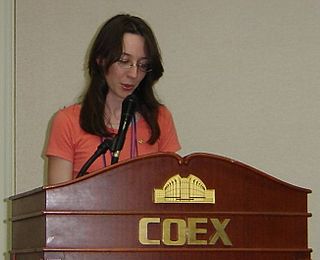
Broadcasting is the distribution of audio or video content to a dispersed audience via any electronic mass communications medium, but typically one using the electromagnetic spectrum, in a one-to-many model. Broadcasting began with AM radio, which came into popular use around 1920 with the spread of vacuum tube radio transmitters and receivers. Before this, all forms of electronic communication were one-to-one, with the message intended for a single recipient. The term broadcasting evolved from its use as the agricultural method of sowing seeds in a field by casting them broadly about. It was later adopted for describing the widespread distribution of information by printed materials or by telegraph. Examples applying it to "one-to-many" radio transmissions of an individual station to multiple listeners appeared as early as 1898.
Topcoder is a crowdsourcing company with an open global community of designers, developers, data scientists, and competitive programmers. Topcoder pays community members for their work on the projects and sells community services to corporate, mid-size, and small-business clients. Topcoder also organizes the annual Topcoder Open tournament and a series of smaller regional events.
Collaborative intelligence characterizes multi-agent, distributed systems where each agent, human or machine, is autonomously contributing to a problem solving network. Collaborative autonomy of organisms in their ecosystems makes evolution possible. Natural ecosystems, where each organism's unique signature is derived from its genetics, circumstances, behavior and position in its ecosystem, offer principles for design of next generation social networks to support collaborative intelligence, crowdsourcing individual expertise, preferences, and unique contributions in a problem solving process.
LIVE365 is an Internet radio network where users are able to create their own online radio stations, or choose to listen to thousands of human curated stations. LIVE365 is unique because online radio stations on the LIVE365 network were created and managed by music and talk enthusiasts, including both hobbyists and professional broadcasters. LIVE365 also has many well established AM and FM stations that utilized the LIVE365 broadcasting platform to simulcast their terrestrial radio streams via the Live365 distribution network. The Live365 network also features radio stations from well-known artists such as Johnny Cash, David Byrne, Pat Metheny, Jethro Tull, Frank Zappa, and more. LIVE365 was created in 1999, and remains one of the longest running internet radio websites for listeners and broadcasters.
Open innovation is a term used to promote an information age mindset toward innovation that runs counter to the secrecy and silo mentality of traditional corporate research labs. The benefits and driving forces behind increased openness have been noted and discussed as far back as the 1960s, especially as it pertains to interfirm cooperation in R&D. Use of the term 'open innovation' in reference to the increasing embrace of external cooperation in a complex world has been promoted in particular by Henry Chesbrough, adjunct professor and faculty director of the Center for Open Innovation of the Haas School of Business at the University of California, and Maire Tecnimont Chair of Open Innovation at Luiss.

Citizen media is content produced by private citizens who are not professional journalists. Citizen journalism, participatory media and democratic media are related principles.
Human-based computation (HBC), human-assisted computation, ubiquitous human computing or distributed thinking is a computer science technique in which a machine performs its function by outsourcing certain steps to humans, usually as microwork. This approach uses differences in abilities and alternative costs between humans and computer agents to achieve symbiotic human–computer interaction. For computationally difficult tasks such as image recognition, human-based computation plays a central role in training Deep Learning-based Artificial Intelligence systems. In this case, human-based computation has been referred to as human-aided artificial intelligence.
An ideas bank is a widely available shared resource, usually a website, where people post, exchange, discuss, and polish new ideas. Some ideas banks are used to develop new inventions or technologies. Many corporations have installed internal ideas banks to gather the input from their employees and improve their ideation process. Some ideas banks employ a voting system to estimate an idea's value. In some cases, ideas banks can be more humor-oriented than their serious counterparts. The underlying theory of an ideas bank is that if a large group of people collaborate on a project or the development of an idea that eventually said project or idea will reach perfection in the eyes of those who worked on it.

Crowdsourcing involves a large group of dispersed participants contributing or producing goods or services—including ideas, votes, micro-tasks, and finances—for payment or as volunteers. Contemporary crowdsourcing often involves digital platforms to attract and divide work between participants to achieve a cumulative result. Crowdsourcing is not limited to online activity, however, and there are various historical examples of crowdsourcing. The word crowdsourcing is a portmanteau of "crowd" and "outsourcing". In contrast to outsourcing, crowdsourcing usually involves less specific and more public groups of participants.
Cambrian House began as a crowdsourcing community that pioneered the technology to tap crowds for the best software ideas. To power open innovation in other businesses, they developed a crowdsourcing platform Chaordix – the technology to harness a crowd for breakthrough ideas.
InnoCentive is an open innovation and crowdsourcing company with its worldwide headquarters in Waltham, MA and their EMEA headquarters in London, UK. They enable organizations to put their unsolved problems and unmet needs, which are framed as ‘Challenges’, out to the crowd to address. In the case of InnoCentive, the crowd can either be external or internal. Awards, typically monetary, are given for submissions that meet the requirements set out in the Challenge description. The average award amount for a Challenge is $20,000 but some offer awards of over $100,000. To date, InnoCentive have run over 2,000 external Challenges and over 1,000 internal Challenges, awarding over $20 million in the process.
The URBAN AND REGIONAL INNOVATION Research (URENIO) is a university lab in the Department of Urban and Regional Planning, School of Engineering at the Aristotle University of Thessaloniki. URENIO is a non-profit research organization that started its operation in 1995. URENIO is mainly involved in competitive projects from the European R&D Framework Programs (FP), the Competitiveness and Innovation Program (CIP), the territorial cooperation programs, the OECD, and the United Nations.
Innovation management is a combination of the management of innovation processes, and change management. It refers to product, business process, marketing and organizational innovation. Innovation management is the subject of ISO 56000 series standards being developed by ISO TC 279.

Social collaboration refers to processes that help multiple people or groups interact and share information to achieve common goals. Such processes find their 'natural' environment on the Internet, where collaboration and social dissemination of information are made easier by current innovations and the proliferation of the web.

Jelli is a San Mateo, California-based advertising technology firm, which develops solutions for the programmatic sale and airplay of radio advertising.
Citizen sourcing is the government adoption of crowdsourcing techniques for the purposes of (1) enlisting citizens in the design and execution of government services and (2) tapping into the citizenry's collective intelligence for solutions and situational awareness. Applications of citizen sourcing include:
Crowdsourcing software development or software crowdsourcing is an emerging area of software engineering. It is an open call for participation in any task of software development, including documentation, design, coding and testing. These tasks are normally conducted by either members of a software enterprise or people contracted by the enterprise. But in software crowdsourcing, all the tasks can be assigned to or are addressed by members of the general public. Individuals and teams may also participate in crowdsourcing contests.
Government crowdsourcing is a form of crowdsourcing employed by governments to better leverage their people's collective knowledge and experience by tapping into their ability to see connections, understand issues, and coordinate action. It has tended to take the form of public feedback, project development, or petitions in the past, but has grown to include public drafting of bills and constitutions, among other things. This form of public involvement in the governing process differs from older systems of popular action, from town halls to referendums, in that it is primarily conducted online or through a similar IT medium.
Patexia Inc. is a privately held intellectual property (IP) company based in Santa Monica, California, U.S. The company was founded in 2010 with the mission to enhance transparency and efficiency in the IP field through a leveraging of the knowledge of an IP-based online community of researchers, attorneys, and stakeholders—described by the company as a “multidisciplinary social network”—for the purpose of information crowdsourcing. In addition, the company combines patent and litigation databases to provide analytical tools regarding the IP field, including the details of attorneys, law firms, companies, and examiners, for its community members.




